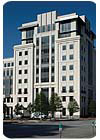
The First Citizens Bank headquarters office complex in Columbia, SC, features 83,000 square feet of exterior wall comprised of glass and Golden Beach limestone from Portugal. A variety of other stone materials were implemented throughout the facility, and all materials were processed and supplied through Henraux of Carrara, Italy.<

Duda/Paine Architects tried out a number of stone finishes and ultimately selected a honed finish for the second floor and above because it allowed for “wonderful uniformity and nice luster,†according to Duda. “The [stone installed from the] second floor down features an acid washing process, which gives texture to the surface,†he explained. “The process makes veins or harder materials stand out and gives a wonderful texture that you can read when shadows fall on it.â€
According to Design Principal Turan Duda from Duda/Paine Architects, LLP, of Durham, NC, the bank's founder had been dreaming about this project for the past 40 years. “The first thing the owner said was that he wanted the building to look as if it had always been here - that it belonged here,†the architect explained. “He wanted it to have a sense of permanence and timelessness.â€
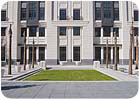
The exterior also features an Autumn Brown granite base in a thermal finish because it is “a forgiving material and weathers well,†according to the architect.
The exterior facade is clad in 65,000 square feet of Golden Beach limestone, which was quarried in Portugal and fabricated by Henraux in Italy. “We knew we wanted limestone, which is a material with a lot of warmth,†said Duda. “It was important to us that it have a natural glow to it. Even on a rainy day it looks like the sun is shining on this material.
“We were fortunate that Henraux found the perfect material for us - with its very warm beige color,†the architect continued. “It also has something that most limestones don't, which is a light veining throughout that gives it texture and a sense of character. It was important to me that the exterior stone on the building have variation and movement, and the veining throughout this material has all those qualities. It is structurally sound and a very dense material.â€
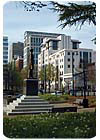
The exterior facade is comprised of 18,700 pieces of stone, with the typical size measuring about 22 x 44 inches. To avoid complications and high costs, the stone was installed using a unique curtainwall system that was designed and manufactured by Baker Metal Products, Inc.
The wall is comprised of 18,700 pieces of stone, with the typical piece measuring an average of 22 x 44 inches. To avoid complications and high costs, the stone was installed using a unique curtainwall system that was designed and manufactured by Baker Metal Products, Inc. The company developed a unitized curtainwall design that simplified the edge of slab details and supported the extended faces of stone on aluminum trusses. The aluminum trusses were factory assembled in Dallas, TX - at Baker Metal Products' facility - and the limestone, with thicknesses ranging from 1 _ to 4 inches, was factory installed on the trusses. Each assembled truss weighed about 3,000 pounds and was set on the jobsite with a tower crane.
The exterior also features an Autumn Brown granite base in a thermal finish. “Granite is a forgiving material and weathers well,†said the architect.
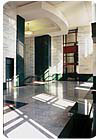
Flooring throughout the interior features Gray Tapestry granite, while the walls are clad in Arabescato Cerviole marble.
Interior Stonework
Natural stone was also carried indoors as U.S.-quarried Gray Tapestry granite was selected for the flooring because of its durability. “Inside, we have a very classic selection of material,†said Duda. “This material has a gray swirl pattern that gives just enough movement and activity and it makes a beautiful field granite. We also used a bordering device - a black granite paver referred to as Nero Zimbabwe, which is from Africa.†The floor also features accent pavers of Rojo Alicante marble, which comes from Spain.The interior walls feature honed Arabescato Cerviole marble from Italy. Duda described the material as a beautiful white material with grayish veining throughout. “What we really liked about the material was its translucent quality,†he said. “It looks like it is emitting light.â€
Ocean Verde marble - quarried in Guatemala - was used for vertical interior walls, as well as for the wainscoting at the bottom of the interior walls, and as a framing device on openings such as windows.
Another significant highlight of the project is a grand staircase, which connects a two-level lobby. The staircase features Fior De Pesco marble from Northern Italy. “It is the perfect gray marble with white and pinkish veins,†said the architect. “We also used the material as an art wall by creating two very large sculpted forms on either side of the stairs in a bookmatched pattern.â€

Nero Zimbabwe black granite from Africa was used as a bordering device to complement the gray granite flooring. The floor also features accent pavers of Rojo Alicante marble, which was quarried in Spain.
Overcoming obstacles
According to Duda, who wanted the facade to have depth and shadowed reliefs of solid stone, challenges of working with the thin stone veneers used today were overcome by significant teamwork and state-of-the-art technology. “If you think about how buildings like this were put together in the past - large pieces of stone measuring 1 foot thick or 8 inches thick - had to be cut in order to create the type of relief we have here,†he explained. “Most of the stones we used are no more than 2 inches thick to create variation shadow lines, deep recesses and reveals. Having Bob Baker [from Baker Metal Products, Inc.] on the job was absolutely essential. He engineered a way to employ a panelized system. He fabricated and assembled the wall panels in his shop on a skeleton of aluminum, and then hung these panels on site. If we tried piece by piece, it would have been absolutely impossible to create the kind of surface we wanted with such thin veneer.
“What we really liked about the material was its translucent quality,†said the architect about the Arabescato Cerviole marble. “It looks like it is emitting light.â€
According to Duda, technology was absolutely critical to the success of the building. “Being able to use thinner stone material with an aluminum backing allowed us to make the walls much lighter in weight and saved costs as far as structure is concerned,†he said.
Construction on the 177,000-square-foot structure began in July 2004 and was completed in March 2006. “We are delighted that it has been so wonderfully embraced by the residents of the city of Columbia,†said Duda.
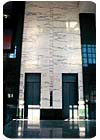
Duda describes Arabescato Cerviole marble as “a beautiful white material with grayish veining throughout.â€
Columbia, SC
Design Architect: Duda/Paine Architects, LLP, Durham, NC
Architect of Record: Stevens & Wilkinson of South Carolina, Inc.
Stone Supplier/Processor: Henraux, Carrara, Italy
General Contractor: Holder Construction Co., Atlanta, GA
Manufacturer/Designer: Baker Metal Products, Inc., Dallas, TX (curtainwall system)
Subcontractor: Harris/Carnter Wall Systems, Inc. (curtainwall)
Curtainwall Erector: Curtainwall Erectors, Inc.